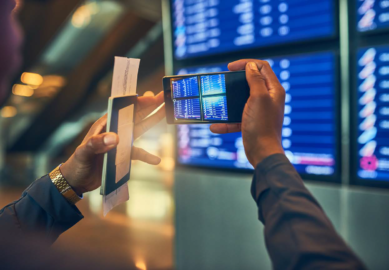
New report from WEF describes future travellers’ ‘digital identity’
By cameron in Uncategorized
A new report from the recent World Economic Forum aims to break down the barriers to a saner means of vetting airline passengers.
People have considered passenger facilitation and ensuring border security to be mutually exclusive, the report says, and trusted-traveler and registered traveler programs can’t by themselves achieve the paradigm shift toward a “Known Traveller Digital Identity concept” that will radically transform the way in which legitimate travellers are securely and seamlessly facilitated across borders.
And something’s got to give: Cross-border travel will grow by 50% over the next decade and reach 1.8 billion international arrivals by 2030, a situation that experts predict will be unsustainable for the current aviation security system.
The report, titled “The Known Traveller: Unlocking the potential of digital identity for secure and seamless travel,” recommends the Known Traveller Digital Identity concept as the first step toward achieving a systemic shift.
But stakeholders must act now to come up with and refine prototype policies and processes, build momentum to encourage behavioral change and create a framework that preserves both cybersecurity and personal privacy.
Achieving that balance won’t be easy. For example, the report notes that the source of some traveler frustration is that information is not reused must be provided repeatedly. Yet the EU’s new General Data Protection Regulation regulation this year enabled individuals to request the deletion or removal of personal data where there is no compelling reason for its continued processing.
Opinions may differ on what constitutes a compelling reason.
The Known Traveller Digital Identity concept will provides the opportunity for law enforcement, immigration and aviation security officials to request and receive verified information from travellers far sooner in their journey.
That will allow authorities to shift toward increased advanced passenger screening and the clearance of low-risk travellers. In turn, officials will have more time to focus their efforts on vetting passengers who are less well known or who raise more concerns.
The advance access would allow for risk-based immigration lanes where, for example, one lane is for pre-screened travellers and a second is for those who have not provided their information upfront.
Proponents of the concept say it is based on the idea that an individual is in control of providing specific identity information (e.g., biometric, biographic and travel history) to governmental and private-sector players along the journey, such as border control agencies, car rentals, hotels and airlines, for risk profiling, verification and access.
 The traveler can select which information is shared for a specific time according to the authority or private entity’s requirements to access the services.
The traveler can select which information is shared for a specific time according to the authority or private entity’s requirements to access the services.
The identity of the traveller is authenticated through biometric verification and protected by distributed ledger technology, such as blockchain technology, and cryptography.
The report cites IATA’s One ID initiative as an example of a potential “friction-free and passenger-centric process that allows an individual to assert their identity, online or in person, to the required level at every process step in the end-to-end passenger journey, while maintaining the privacy of personal data.”
IATA believes that:
“If a passenger’s identity can be confirmed at every touchpoint, it will become easier to deliver a more personalized customer experience, while enabling significant improvements in operational efficiency and security. To achieve this, true collaboration between stakeholders will be paramount.”
But it is clear that the element of trust will be essential to “a cohesive vision for the future of security in travel.” The vision must include “user-centricity, digitization and trustful cooperation,” the report stated.
“The Known Traveller” report is available here.
![]()

